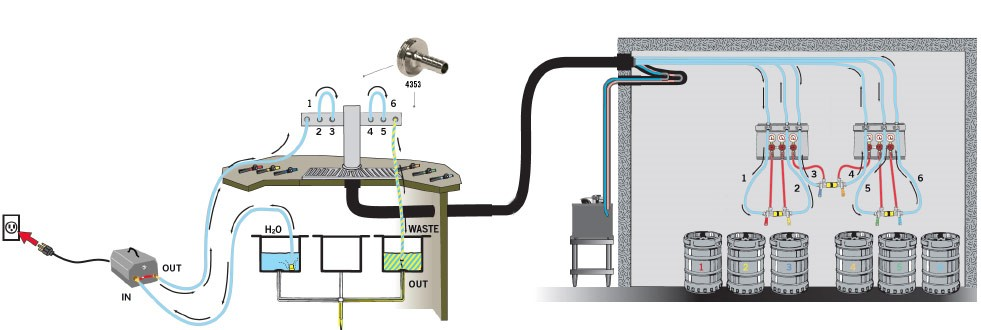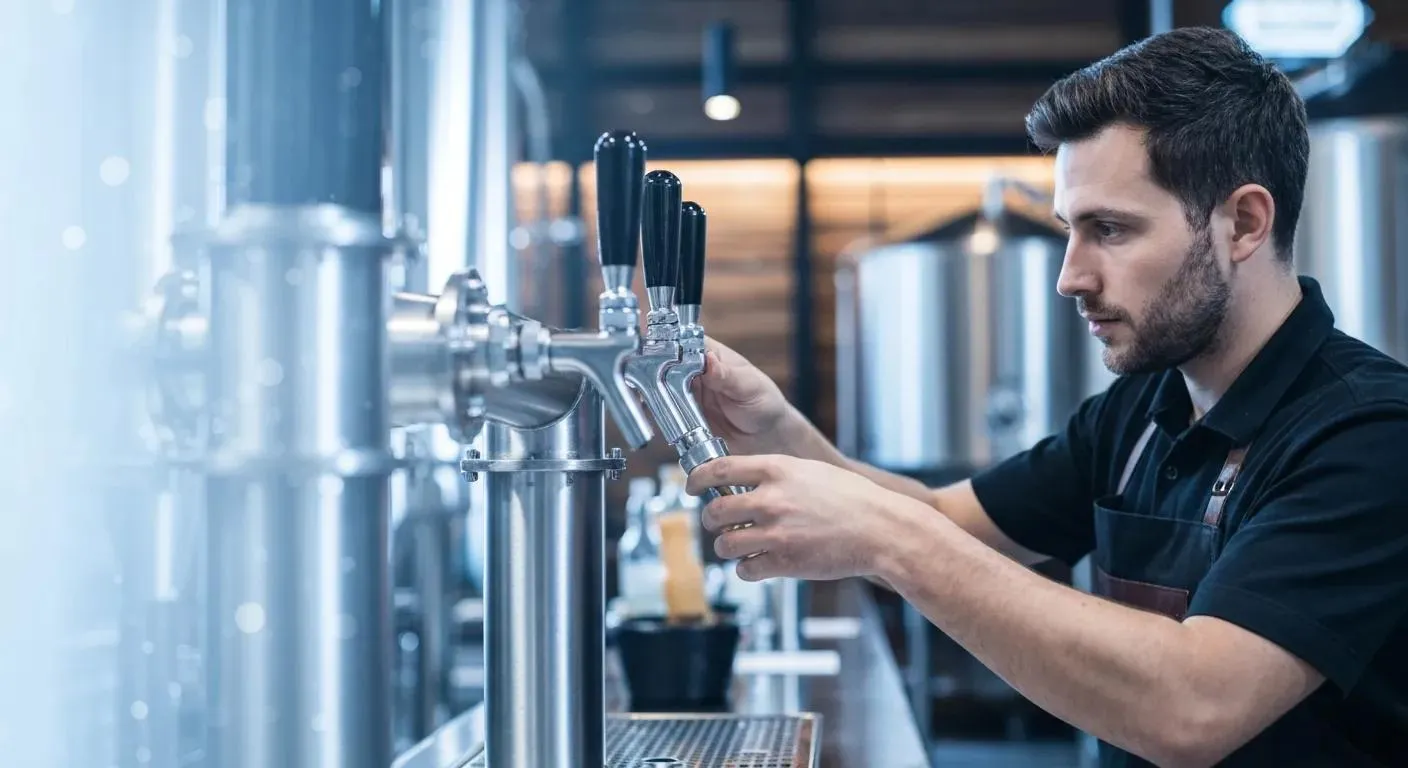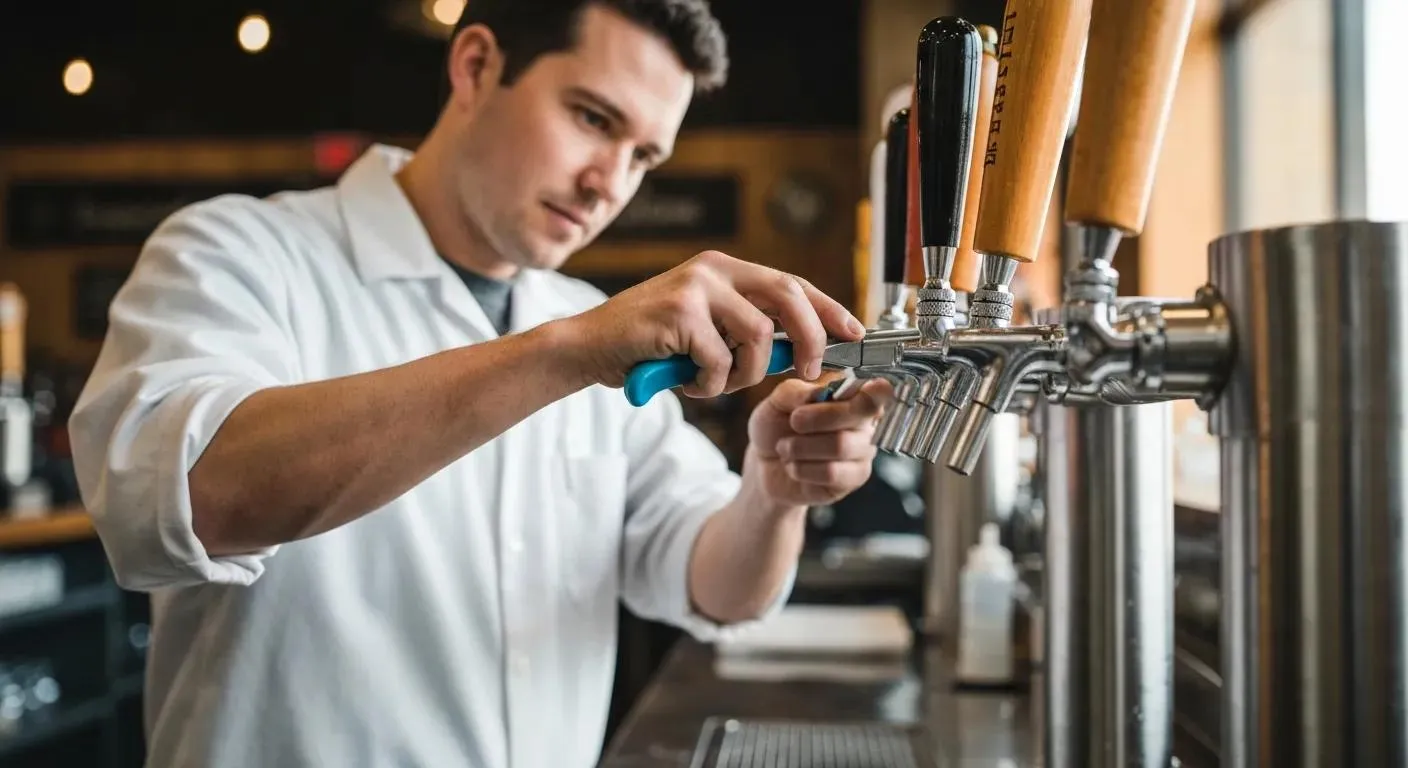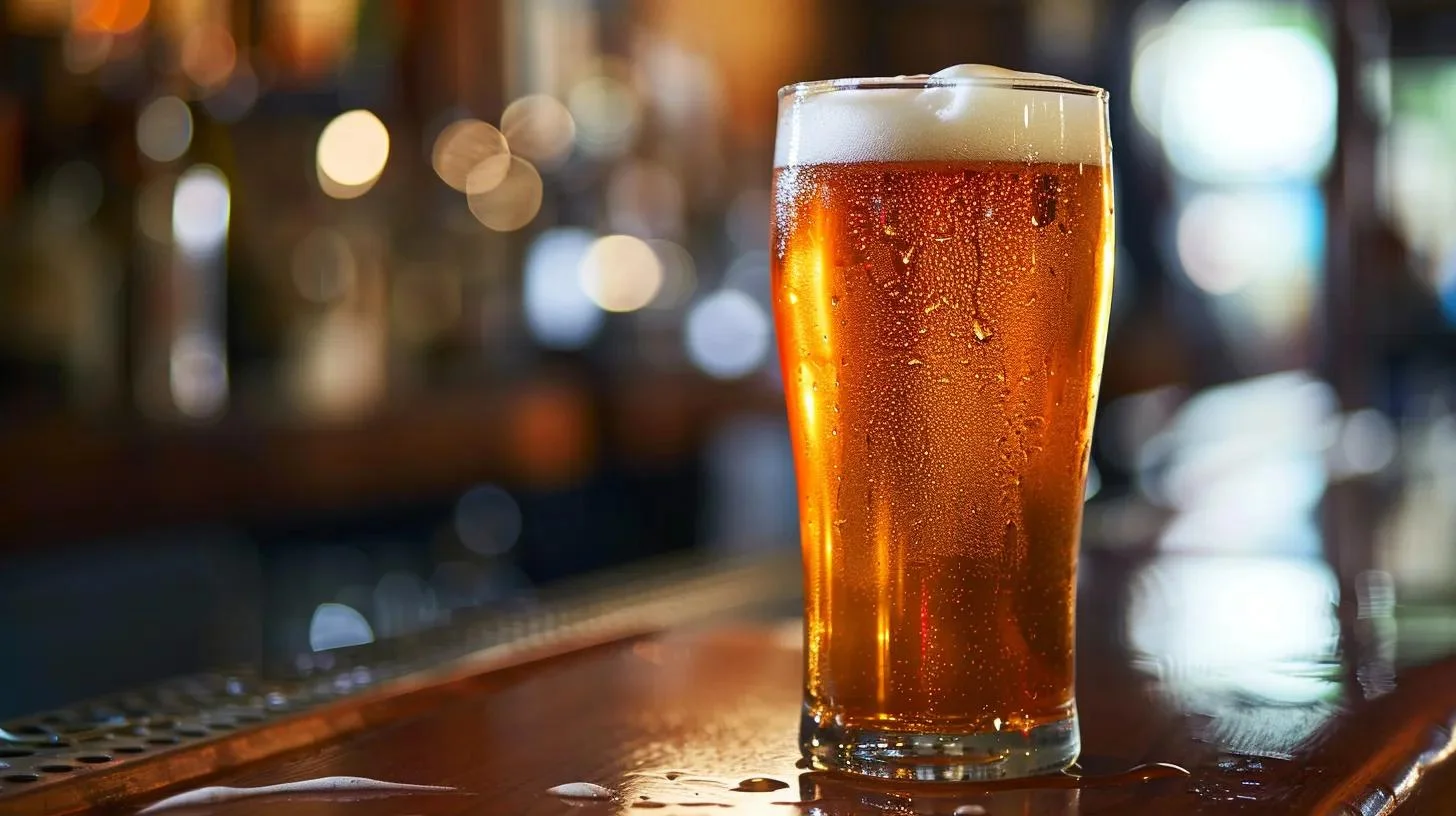Recirculating Beer Line Cleaner Pump Vs Cleaning Keg Which Is The Best?

If your draft beer’s taste is less than stellar, the culprit might be unclean beer lines. Enter the beer line cleaner pump: an efficient tool designed to tackle this issue head-on. This article will offer a detailed comparison between using a cleaner pump and a cleaning keg, explaining how these methods can affect both the taste of your beer and the longevity of your beer lines.
Key Takeaways
- Consistent beer line cleaning every two weeks or after every couple of kegs is essential to prevent off-flavors and health risks due to bacterial and yeast build-up.
- Recirculating pump systems are more efficient than cleaning kegs for beer line maintenance, providing thorough coverage and saving time by cleaning multiple lines simultaneously.
- Regular maintenance, including proper cleaning equipment storage and detailed records of cleaning schedules, is crucial for maintaining beer quality and equipment longevity.
Understanding Beer Line Cleaning

If you’ve ever tasted a beer that’s off, chances are the beer lines haven’t been cleaned regularly. Dirty beer lines can significantly affect the taste and quality of the beer, resulting in a less enjoyable drinking experience. From yeast build-up to bacterial contamination, unclean beer lines can host an array of unwelcome guests that can mess with your beer’s flavor and aroma.
To ensure your beer tastes as the brewer intended, a consistent cleaning routine is necessary. This involves disconnecting the draft system and thoroughly flushing the lines with water and a suitable cleaning solution to get rid of any residual gunk.
The Impact of Dirty Beer Lines
Dirty beer lines don’t just ruin the taste of your beer - they can also pose health risks. The bacteria build-up in unclean beer lines can potentially lead to health issues like upset stomach, nausea, and headaches.
Therefore, keeping your beer lines clean isn’t just about maintaining the highest beer quality at your beverage factory; it’s also about ensuring the safety and satisfaction of your customers.
Frequency of Beer Line Cleaning
When it comes to how often you should clean your beer lines, the industry-standard recommends a thorough clean every two weeks. However, the frequency can also depend on the type of beer and whether it’s filtered or not. For example, unfiltered beers may require a more frequent cleaning schedule.
Regular cleaning every couple of kegs or every two weeks ensures that your beer maintains its top-notch quality.
Types of Beer Line Cleaning Methods
There are several methods to clean your beer lines, but the most common ones are using a cleaning keg and a recirculating pump. Both methods aim to maintain the quality of your beer by preventing yeast and bacteria build-up. However, they differ in the way they are executed and their effectiveness in cleaning your beer lines.
Cleaning kegs work by pushing a cleaning solution through the lines using pressure. On the other hand, recirculating pumps circulate a cleaning solution through the entire beer system for a certain period, usually 15-20 minutes ensuring a thorough clean. Let’s delve deeper into these methods and see how they compare.
Cleaning Keg
The cleaning keg method is a popular and effective way to clean beer lines. Here’s how it works: you fill an extra keg with a specific cleaner, pressurize it with CO2, and then blast the solution through the lines. This process helps keep the beer looking, smelling, and tasting great, making for a better customer experience.

However, this method does come with a few drawbacks. There’s the possibility of mold growth if the keg isn’t properly cleaned and stored. Also, you need to turn off remote coolers while cleaning, which can be inconvenient.
Despite these challenges, the cleaning keg method remains a favorite among many due to its effectiveness in maintaining beer quality.
Recirculating Pumps
Recirculating line cleaning pumps take beer line cleaning to the next level. These devices circulate a cleaning solution through the entire beer system, ensuring that every nook and cranny of your beer lines gets a thorough clean. This method not only saves you time and effort but also ensures a more effective clean compared to traditional methods.

What makes recirculating pumps so impressive is their ability to create a powerful flow that is 80 times more effective than simply soaking the lines. This means that every part of your beer line system gets cleaned, guaranteeing a better-tasting and higher-quality beer.
Essential Beer Line Cleaning Equipment and Accessories
Whether you’re using a cleaning keg or a recirculating pump, there are several essential pieces of equipment and accessories necessary for effective beer line cleaning. These include:
- Safety glasses
- Rubber gloves
- A cleaning jar with a pump
- A suitable cleaning solution
The cleaning solution is particularly important as it helps get rid of yeast and mold, ensuring that your kegerator or draft system remains clean and pure.
But beyond the equipment, there are also some specific cleaning solutions and accessories that can make the process even more efficient and effective. Let’s take a closer look at these.
Cleaning Solutions
Cleaning solutions play a crucial role in beer line cleaning. They contain active ingredients that break down organic matter such as yeast, protein, and beer stone that can build up in beer lines. There is a variety of cleaning solutions available, including:
- Penetrate Beer Line Cleaning Liquid
- BTF Iodophor Sanitizer
- ALC Acid Beverage Draft Beer
- Oxiclean/TSP mixture
- Micro Matic beer line cleaner
When choosing a cleaning solution, it’s important to select one that is chlorine-free and no-rinse. Some even contain potassium hydroxide for an added cleaning boost. And, for safety and ease of use, it’s recommended to go for products from reputable brands like Kegworks and Micro Matic.
Brushes and Adapters
Brushes and adapters are other essential accessories for beer line cleaning. Brushes are used to scrub the inside of beer lines, getting rid of any stubborn build-up. Adapters, on the other hand, allow you to clean multiple beer lines at once, making the whole process much quicker and easier.
When choosing brushes and adapters, consider the following:
- How well they work with your cleaning system
- The type of bristles on the brushes
- Whether the adapters allow for the simultaneous cleaning of multiple beer lines.
Why Beer Line Cleaner Pump Is Best

While both cleaning kegs and recirculating pumps are effective for beer line cleaning, the latter stands out for several reasons:
- A recirculating pump ensures a thorough and efficient clean
- It guarantees that the cleaning solution reaches all areas of your beer lines
- It saves time as it cleans multiple lines at the same time.
But the benefits of a recirculating pump go beyond its cleaning prowess. It also plays a role in maintaining optimal beer quality, preventing scaling and mineral deposits caused by the acidity of beer. Let’s delve deeper into why a recirculating pump is the preferred choice for beer line cleaning.
Price and Value Considerations
When it comes to cost, a recirculating pump can range from $600 to $1,070 on average, while a cleaning keg system can start at $85 plus $5 per extra line beyond 10 lines. While the initial cost of a recirculating pump may be higher, it’s an investment that pays off in the long run due to its efficiency and effectiveness in cleaning beer lines.
Moreover, for those on a budget, there are cheaper alternatives like a smaller pump with a 1/4” Flare attachment or an inexpensive aquarium pump from Amazon. These can work as cost-effective alternatives for cleaning beer lines.
Compatibility with Your Draft Beer System
Another great advantage of recirculating pumps is their compatibility with various draft beer systems, including remote glycol-cooled, air-cooled, and direct draw systems. They can easily connect to the draft beer system.
To ensure smooth operation, always ensure that your recirculating pump is low pressure and works well with all other parts of your system. And for different beer systems, you may need adapters that can connect the pump to a garden hose or screw into the carb cap for beer line cleaning.
Step-by-Step Guide to Cleaning Your Beer Lines With A Recirculating Pump

Now that we’ve established the benefits of a recirculating pump, let’s walk you through the process of cleaning your beer lines using this method. It’s a straightforward process that involves:
- Setting up the pump system
- Flushing the lines
- Soak Faucets in Cleaning Solution
- Allowing the cleaner to recirculate for a while. 15-20 Minutes
- Flushing the lines again. Use Ph paper to verify the cleaning solution is out of the draft beer system.
- Reattach the draft beer system. Pour Beer Through the Beer System
The whole process should take about 1-2 hours depending on the size of the system, making it a quick and efficient way to ensure your beer lines are clean and ready to serve top-quality beer. However, there are a few steps you need to take before, during, and after cleaning to ensure the best results.
Preparing Your Draft Beer System
Before you start cleaning your beer lines, you need to prepare your draft beer system. This involves:
- Disconnecting the couplers from the kegs
- Turning off the gas supply
- Unplugging the power source for remote systems
- Cleaning and storing the kegs properly.
Next, you’ll need to disconnect the beer faucet, soak it in a cleaning solution, and give it a good scrub. This ensures that the faucet is as clean as the beer lines, ensuring that every part of your draft beer system is clean and ready for use.
Cleaning Process
Once your draft beer system is ready, it’s time to start the cleaning process. Begin by setting up the pump system and flushing the lines with a cleaning solution. Then, let the cleaner recirculate for about 15-20 minutes to ensure a thorough clean.
After the cleaning solution has had time to circulate, flush the lines again to remove any remaining cleaning solution. This step is crucial as it ensures that no cleaning solution residue remains in the beer lines.

Rinsing and Reassembling
After cleaning, the next step is rinsing and reassembling your draft beer system. To rinse, you’ll need to run fresh water through the system until the water coming out matches the tap water in pH level and looks debris-free.
Once the system is rinsed, you can start reassembling. This involves:
- Hooking up the coupler to the keg
- Putting on the faucet
- Running some clean water through to ensure all the cleaner is gone
- Pouring a bit of beer to make sure everything is working properly.
Tips for Effective Beer Line Maintenance
Proper beer line cleaning doesn’t end after the rinse and reassembly. Regular maintenance and inspection are crucial to ensuring your beer lines remain clean and your beer tastes its best. This includes checking the beer lines regularly for any dirt or biofilm build-up.
Regular maintenance ensures the longevity of your beer lines and the consistent quality of your beer. And with the right cleaning tools and schedule, you can ensure that your beer always tastes as the brewer intended.
Regular Inspection
Regular inspection of your beer lines is a crucial part of effective beer line maintenance. This involves checking your beer lines for cleanliness at least once every six weeks. You should also clean and sanitize the tap lines between each keg to ensure optimal beer quality.
Neglecting regular inspection of your beer lines can lead to a build-up of bacteria, affecting the taste and smell of your beer. It won’t necessarily make people sick, but it can make the beer taste off, giving your bar or brewery a bad reputation.
Keeping Records
Keeping records of your beer line cleaning schedule and maintenance is a crucial part of effective beer line maintenance. This helps ensure that you’re meeting health and safety standards and provides a clear record of your cleaning routine.
Remember to document critical information like the date and time of cleaning, the person who did it, the equipment used, and any issues noticed during the cleaning.
Proper Storage of Cleaning Equipment
Proper storage of your beer line cleaning equipment is essential for its longevity and effectiveness. This involves cleaning your equipment right after use to prevent gunk and damage, and properly storing them to keep them in good working condition.
Also, remember to rinse your lines with water after cleaning to keep them in good shape. And when storing your equipment, either let them dry out after using and draining them or clean, rinse, and store them filled with water to prevent any damage.
Summary
Throughout this guide, we’ve covered the importance of beer line cleaning and the different methods available. We’ve also touched on the essential equipment needed for effective beer line cleaning and provided a step-by-step guide on cleaning your beer lines with a recirculating pump.
However, it’s important to remember that beer line cleaning is not a one-time task but a regular part of your draft beer system’s maintenance. Regular cleaning and inspection of your draft lines and beer lines ensure that your beer tastes its best and your customers are always satisfied.



